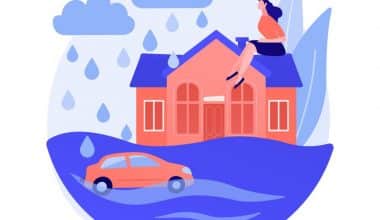A peril is a specific cause of harm or damage. Many insurance plans provide coverage for different types of perils, such as theft, wind, and fire. In the insurance industry, “peril” and “hazard” have very different meanings, despite their seeming similarities.
Peril in Insurance
Some of the types of perils that homeowner’s, condo, and renter’s insurance typically cover are fire, lightning, and vandalism. Your insurer will cover the remaining cost of repair, replacement, or reconstruction if an insured peril destroys your home or property, less your deductible. A “hazard” is something that raises the probability of some kind of danger.
Insurance perils include, but are not limited to, fire, lightning, high winds, theft, and vandalism. Threats to your home or possessions from any source are also perils. Losses can be insured against in the event of “covered perils,” as defined by the policy, or “uncovered perils,” also known as “exclusions,” as defined by the policy’s terms.
Types of Peril in Insurance
A hazard is something that poses a real risk of injury or destruction to people or things. In addition to protecting yourself from legal repercussions, home insurance can help you avoid financial ruin in the event of certain disasters.
Coverage for your home and possessions under homeowner’s insurance can be limited to “named perils” or “all perils,” respectively.
#1. Named Perils
This type of peril guarantees the protection of your property against the risks listed in your policy. Named peril claims require proof that one of the perils covered by your policy caused the loss or damage. Named-peril policies cover only the risks listed in the policy. Other names for named-peril insurance are closed-peril, specified-peril, or named-risk insurance.
In essence, named peril insurance protects against the types of damage specified in the policy. Then, in order to receive compensation, you, as the policyholder, must show your insurance company that a covered peril was to blame for the damage.
#2. Open Perils
If you have “open perils coverage,” also called “all risks insurance coverage,” then any damage you suffer is compensated for, unless otherwise stated. For your home, open peril coverage is also required. It will raise your premium, but it is essential. Remember that open peril coverage is not normally purchased with renters insurance because contents are usually covered on a named peril basis.
If you file a claim with open peril coverage, the insurer must prove the loss or damage is not covered. Other names for this type of insurance are all-risks coverage, special-peril, and open-peril.
Common Examples of Homeowners’ Perils
Typically, homeowner’s insurance covers the following common perils:
#1. Fire and Smoke
Typically, insurance covers fire damage (including smoke damage) to residences, possessions, and other buildings like sheds or garages. If a home’s condition requires its occupants to relocate for a while, most policies will help with living expense reimbursement.
#2. Lightning Strikes
Typically, homeowner’s insurance will cover lightning damage. You might be able to get compensation from your insurance company, for instance, if lightning-related power surges damaged your electronic devices.
#3. Windstorms and Hail
Even if a tornado was the cause of the damage, the majority of policies would cover it. Insurance typically covers hail, wind-driven rain or snow, as well as other types of storm damage. You should read your policy thoroughly to find any clauses that exclude coverage.
#4. Explosion
No matter where they come from—an aerosol can or a propane grill—explosions in or near a house are always a reason for concern. In most cases, property insurance reimburses policyholders for losses brought on by explosions.
#5. Malicious acts of vandalism and disruption
Homeowners insurance typically pays for damage from these kinds of incidents. If your house or belongings were damaged in the incident, you would have to replace them and repair or rebuild the structure.
#6. Damage Resulting From a Car, Truck, or Airplane
Although car or plane crashes into houses are rare, the results are frequently startling. Thankfully, most homeowner’s insurance policies pay for the cost of fixing any damage that arises from an incident of this kind.
#7. Theft
If an intruder breaks a window or door and you need to replace it, your homeowner’s insurance will probably pay for it. Most home insurance policies will cover the loss or damage to personal property, including items that have been stolen. It is equally important to know that different policies have vastly different limits on how much an insurer will pay out for different types of personal property. There may also be an option to purchase extra coverage for your valuables.
#8. Falling Objects
If a meteor or a perfectly healthy tree falls on your house during a storm and causes damage, your homeowner’s insurance might help pay for the repairs.
#9. Weight of Ice, Snow, or Sleet
Your homeowner’s insurance should cover the cost of repairs and replacement if your roof collapses due to heavy, wet snow or ice.
#10. Water Damage
The majority of homeowner’s insurance policies also cover repairs made after an unintentional and unexpected burst in a pipe or water heater. If a pipe or water heater bursts because of regular use or a manufacturing defect, the repair costs are not covered.
#11. Internal Water Damage
When water damage occurs suddenly and internally, homeowners insurance usually pays for it. This means that you probably will not have to pay out of pocket if, say, a pipe bursts and floods your basement or if a fire destroys your well pump. To find out what hazards are covered, review your homeowner’s insurance policy.
Which Risks Are Excluded From Homeowners Insurance Coverage?
A list of exclusions—perils that homeowners insurance does not cover—will also be included with your policy.
#1. Flooding
Floods that originate outside of the home are typically not covered by standard homeowner’s insurance policies. Furthermore, sewer backups and seepage-related water damage are not covered. In addition, you will require separate flood insurance to protect your house and possessions from flooding.
#2. Earthquakes
Most policies also do not pay for repairs after earthquakes, tremors, landslides, mudslides, subsidence, or sinkholes. Earthquake insurance, or at least an endorsement providing the same protection, might be an option.
#3. Poor Maintenance or Normal Wear and Tear
The majority of homeowner’s insurance policies do not cover repairs for interior water damage resulting from abuse, neglect, or misuse. This means that you probably will not be compensated if your home has a glaring mold problem or if water damage from a leaking pipe takes months to develop.
#4. Pests or Vermin
Furthermore, coverage does not extend to repairs necessitated by pests such as rodents, termites, bed bugs, or birds. In addition, most homeowner’s policies do not cover the cost of exterminating unwanted pests.
#5. Ordinance or Law
Losses resulting from the application of municipal building ordinances are also not covered under a standard policy. In other words, your homeowner’s insurance will not pay for the work needed to bring your home up to code if the government makes you do it.
#6. Bird and Rodent Damage
Birds and rodents can cause extensive damage to a house by pecking holes in the walls, gnawing through the insulation and wiring, and gnawing through the wood and drywall. However, most homeowner’s insurance policies will not pay for these issues because they can be prevented.
What Is a Covered Peril?
Something your insurance will cover is called a covered peril. Your homeowner’s insurance company will pay for the repairs to your home after a covered loss, such as a fire, theft, vandalism, high winds, or hail, less your deductible. Different types of loss are typically compensated for by different sections of a homeowner’s insurance policy.
When “covered perils” like fire, theft, or natural disasters destroy your home or valuables, your insurance will help pay the costs. You can further make a claim with your homeowner’s insurance company if a covered peril damages your house and possessions. You will receive compensation to help pay for repairs or a new set of belongings if an insured peril caused the damage.
The cost of an insurance policy depends heavily on the likelihood that various risks will materialize. When determining premiums, insurance firms weigh both the frequency with which a hazard may occur and the severity of any resulting claims. It is reasonable to expect a higher premium if a property is more vulnerable to natural disasters like floods and earthquakes. On the other hand, premiums can go down if a particular risk is not covered. Insurers base premiums on the insured property’s overall risk profile, which takes into account its susceptibility to various hazards.
What Is All Perils Home Insurance Coverage
Property insurance with open peril, also known as “all peril” or “all-risk” coverage, protects you against any risk, regardless of whether it is listed in your policy’s exclusions. When it comes to these policies, the burden of proof shifts from you, the policyholder, to the insurance provider. The insurance provider is the one who must prove fault in an open peril policy. It is also important to remember that open peril policies have limitations and do not cover every conceivable type of loss.
Perils vs. Hazards in Home Insurance
A peril is anything that could happen that could result in a loss, such as a fire breaking out in a home. An example of a hazard would be forgetting to bring in the gas can or not having the car’s brakes checked regularly, both of which could lead to or exacerbate a loss.
In insurance, what causes the damage is a peril, and what makes it more likely to occur is a hazard. When talking about property insurance, the terms “perils” and “hazards” are often used interchangeably, despite their differences.
Peril
The word “peril” refers to risk, and it suggests an immediate threat. Typically, the fine print of a policy specifies the risks it covers. Fire, wind, water, and theft are examples of traditional dangers. Note that the language may exclude coverage if the insurance company determines that the insured’s neglect caused or worsened the damage.
Hazard
Hazards are actions, conditions, habits, circumstances, or situations that increase the likelihood of a peril or a loss. The insurance industry classifies hazards as physical, moral, and morale.
#1. Physical Hazards
Physical hazards are situations, acts, or habits that put people in danger. Since smoking raises the possibility of a fire, it is regarded as a physical hazard. Health insurance considers liquid spills, high altitude work, and heavy equipment physical hazards because they increase the risk of severe illness.
#2. Moral Hazards
Moral hazards are actions or behaviors that are wrong. Health insurance companies worry about moral hazards like auto accident victims who inflate their injuries. Moral hazard occurs when a business owner ignores workplace safety. A moral hazard exists when companies do not perform necessary upkeep on their infrastructure.
#3. Morale Hazards
Morale hazards are potentially dangerous behaviors that are careless or reckless. The insurance industry may also be a source of morale problems, according to some theories. A person who knows they will not go bankrupt in the event of a disaster may take fewer precautions to ensure their safety and the safety of their possessions if they have insurance.
People may feel encouraged to sue for financial gain without justification, and this is why the legal system is sometimes seen as a morale hazard.
What Are the 3 Categories of Perils?
Human, Economic, and Natural perils.
Natural disasters, such as hurricanes, volcanoes, and lightning, are examples of threats over which humans have little to no influence. Therefore, human perils would include things like theft, terrorism, war, suicide, faulty products, environmental contamination, terrorism, the devastation of intricate infrastructure, and breaches in electronic security that result in losses that are under an individual’s control. Although some would categorize losses arising from the current economic conditions as human perils, several experts group these losses into a third category that they refer to as economic perils.
Is a Peril an Actual Cause of Loss?
A peril is the thing that directly causes or contributes to a loss. That fire will probably be regarded as a peril if it breaks out in your home.
What Is Basic Peril Coverage?
Your property will only be protected from specific perils if you choose the “Basic” form of insurance coverage. In other words, your property will only be covered against the types of losses that are explicitly mentioned in your policy.
The policy’s basic “Named Peril” coverage does not apply to a peril if it is not specifically named on the declarations page.
What Perils Are Not Covered?
Typically, earthquakes, floods, government seizures, mudslides, ordinance updates, sewage backup, sinkholes, and other similar events do not result in homeowner’s insurance paying out for damage.
Is a Hurricane Considered a Peril?
Hurricanes are not typically included in the “named perils” section. However, the majority of home insurance policies will cover hurricane-related damage.
Although hurricanes are neither specifically included nor excluded, the damage they cause—particularly wind and flooding—often is.
What Is All Perils Deductible?
When filing a claim, the policyholder is responsible for paying the All Perils deductible specified in the policy. The insurance company will pay for anything over $500, which is your deductible. Talk to your insurance agent to learn more about deductibles and other insurance terms.
What Peril Does Basic Homeowners Insurance Not Cover?
Common homeowner’s policies do not pay for repairs after natural disasters, earthquakes, termites, mold, or regular wear and tear.
Conclusion
Endorsements, or add-ons, to a homeowner’s insurance policy can extend coverage for damages beyond what is included in a basic policy. Many perils could affect your home. What kinds of damages to your home are covered depends on the insurer you choose and the policy you purchase.
Having a firm grasp on the idea of peril in insurance is crucial for making sense of the intricate systems of risk management and insurance. Insurance protects us from various perils, or potential sources of damage. It covers a wide range of situations, from natural disasters to accidents caused by humans.
- Hazard Insurance vs. Homeowners Insurance: How Do They Differ?
- MOBILE HOME INSURANCE: HOW DOES IT WORK?
- What Is Hazard Insurance for Homeowners? 2023 Guide
- Broad-Form Insurance: Definition, Coverage & Cost
- HAZARD BUSINESS INSURANCE: What Is It & Why You Need It?






